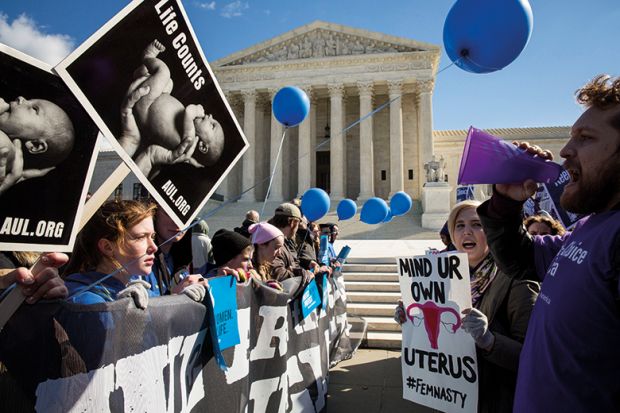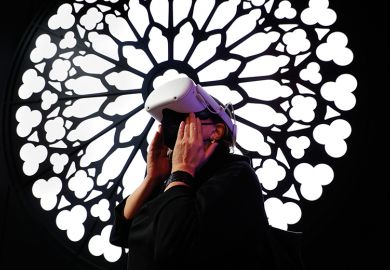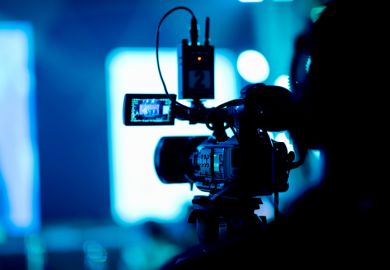Following the results of the US presidential election, many believe we inhabit a political environment defined by polarisation, divisive rhetoric and personal attacks. Certain topics divide society along often-virulent lines.
A new online dictionary featuring contributions from academics that has been created by AllSides – a news hub that offers guidance to readers on the potential political bias of articles and news providers – is hoping to change that.
The AllSides Dictionary attempts to provide a balanced definition of 400 controversial terms, revealing how they are perceived differently by people with different political perspectives. Examples of terms defined include “abortion”, “Black Lives Matter”, “truth” and “white privilege”.
Phil Neisser, one of the editors of the dictionary and a professor in the department of politics at the State University of New York at Potsdam, told Times Higher Education he believes that the dictionary represents a good opportunity for higher education institutions to help students become more rounded in their understanding of controversial topics.
“Universities today are, in some ways, places of potential conflict, because people who have been in their different bubbles – neighbourhoods [and] high schools – come together,” he said. “[University] is an opportunity to build mutual understanding in society – use the setting to get people to sit down and listen [and] talk to people very different from them, and who disagree with them.
“People are more aware that we’re divided. The time is right for us to offer a resource [similar to] Wikipedia, but instead of getting a definition, you get three definitions, in order to create a different kind of conversation.”
Professor Neisser confirmed he was going to use the dictionary in some of his classes, perhaps by having students “put forward to the class what they make of [a] term, make some [of their own] entries” and build that into “some of the things they write in their papers”.
Mikhail Lyubansky, another contributor on the project and a teaching associate professor in the department of psychology at the University of Illinois at Urbana-Champaign, said he also saw the dictionary as a means to get his students to think differently.
“I teach a course on race, and one of the things I want my students to get out of that course is the ability to understand the positionality of people who think differently, who understand the race-related ideas differently than they do,” he said.
“To understand abortion in the US, you have to understand the perspective of the pro-choice and pro-life adherents here. This is a tool that embraces that philosophy, as opposed to the more assimilationist mindset that was dominant prior to that.
“Hopefully [the tool] will help students make sense of what they’re reading, make sense of what they’re hearing in the classroom and make sense of what they’re talking about with their peers.”
Professor Neisser pointed out that although the dictionary had clear educational potential, it’s “one thing to have a dictionary and hope people read it and another thing to require people to read it who are taking a class”. He also noted that the dictionary “should be something that grows”.
“We know that the dictionary is incomplete; it’s got to grow and move with the political times,” he said.
Dictionary definitions: Phil Neisser and Mikhail Lyubansky on defining terms in the AllSides Dictionary
“I spent lots of time listening to the ways that conservatives, leftists and liberals talk about equality, and I did some reading as well. Also, I worked hard to try to understand what they each meant by the word in the first place, instead of just seeing which of their ideas I agreed with,” said Professor Neisser, who wrote the entry.
“It was difficult; I had to find the right words to describe viewpoints that are not my own. Another challenge was finding a way to talk about equality in general, even though there are many different ways people can be (and are) equal and unequal relative to each other.”
Race and Stereotypes
“I came up with the definitions for these entries based on a course I had been teaching since 2000. I start that course by talking about definitions, first showing how popular usage (dictionary definitions) differs from definitions used by social scientists, and then further unpacking popular usage to show how it differs as a function of racial ideology,” said Professor Lyubansky.
“Because I’ve been teaching this content for so long and follow both progressive and conservative discourses on social media, I knew what I wanted to say. The hard part was to write it in a way that was accessible, clear and engaging. Hopefully, I managed to do that and it’s worded in a way that captures the spirit and nuance of each particular political orientation in the way that they would want it captured.”
POSTSCRIPT:
Print headline: Dictionary to help students decipher fake news
Register to continue
Why register?
- Registration is free and only takes a moment
- Once registered, you can read 3 articles a month
- Sign up for our newsletter
Subscribe
Or subscribe for unlimited access to:
- Unlimited access to news, views, insights & reviews
- Digital editions
- Digital access to THE’s university and college rankings analysis
Already registered or a current subscriber? Login







